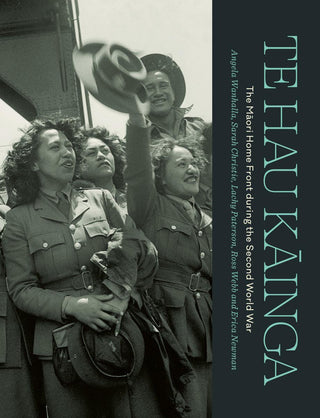Te Hau Kainga: The Maori Home Front during the Second World War
- Unit price
- / per
-
Author:WANHALLA Angela / CHRISTIE Sarah / PATERSON Lachy / WEBB Ross / NEWMAN Erica
-
ISBN:9781869409999
-
Publication Date:November 2024
-
Edition:1
-
Pages:296
-
Binding:Hardback
-
Publisher:Auckland University Press
-
Country of Publication:New Zealand


A Back Order button means that we don’t have the book in stock at our store. It may already be on order – or we can order it for you from a publisher or distributor at no additional cost.
As we source items from around the globe, a back-order can take anywhere from 5 days to several weeks to arrive, depending on the title.
To check how long this might take, you’re welcome to contact us and we can provide an ETA or any other information you need. We recommend checking the timeframe before committing to an online order.
Te Hau Kainga: The Maori Home Front during the Second World War
- Unit price
- / per
-
Author:WANHALLA Angela / CHRISTIE Sarah / PATERSON Lachy / WEBB Ross / NEWMAN Erica
-
ISBN:9781869409999
-
Publication Date:November 2024
-
Edition:1
-
Pages:296
-
Binding:Hardback
-
Publisher:Auckland University Press
-
Country of Publication:New Zealand
Description
The illustrated account of how Māori society was transformed at home while the Māori Battalion were fighting overseas.
Taking readers to the farms and factories, the marae and churches where Māori lived, worked and raised their families, Te Hau Kainga tells the story of the profound transformation in Māori life during the Second World War.
While the Māori Battalion fought overseas, the Māori War Effort Organisation and its tribal committees engaged Māori men and women throughout Aotearoa in the home guard, the women’s auxiliary forces, and national agricultural and industrial production. Māori mobilisation was an exercise of rangatiratanga and it changed how Maori engaged with the state. And, as Māori men and women took up new roles, the war was to become a watershed event for Māori society that set the stage for post-war urbanisationFrom ammunition factories to kumara fields, from Te Puea Herangi to Te Paipera Tapu, Te Hau Kainga provides the first substantial account of how hapori Māori were shaped by the wartime experience at home. It is a story of sacrifice and remarkable resilience among whanau, hapu and iwi Māori.
Adding product to your cart
You may also like
A Back Order button means that we don’t have the book in stock at our store. It may already be on order – or we can order it for you from a publisher or distributor at no additional cost.
As we source items from around the globe, a back-order can take anywhere from 5 days to several weeks to arrive, depending on the title.
To check how long this might take, you’re welcome to contact us and we can provide an ETA or any other information you need. We recommend checking the timeframe before committing to an online order.
You may also like
You may also like
-
The illustrated account of how Māori society was transformed at home while the Māori Battalion were fighting overseas.
Taking readers to the farms and factories, the marae and churches where Māori lived, worked and raised their families, Te Hau Kainga tells the story of the profound transformation in Māori life during the Second World War.
While the Māori Battalion fought overseas, the Māori War Effort Organisation and its tribal committees engaged Māori men and women throughout Aotearoa in the home guard, the women’s auxiliary forces, and national agricultural and industrial production. Māori mobilisation was an exercise of rangatiratanga and it changed how Maori engaged with the state. And, as Māori men and women took up new roles, the war was to become a watershed event for Māori society that set the stage for post-war urbanisationFrom ammunition factories to kumara fields, from Te Puea Herangi to Te Paipera Tapu, Te Hau Kainga provides the first substantial account of how hapori Māori were shaped by the wartime experience at home. It is a story of sacrifice and remarkable resilience among whanau, hapu and iwi Māori.
-
-
Author: WANHALLA Angela / CHRISTIE Sarah / PATERSON Lachy / WEBB Ross / NEWMAN EricaISBN: 9781869409999Publication Date: November 2024Edition: 1Pages: 296Binding: HardbackPublisher: Auckland University PressCountry of Publication: New Zealand
The illustrated account of how Māori society was transformed at home while the Māori Battalion were fighting overseas.
Taking readers to the farms and factories, the marae and churches where Māori lived, worked and raised their families, Te Hau Kainga tells the story of the profound transformation in Māori life during the Second World War.
While the Māori Battalion fought overseas, the Māori War Effort Organisation and its tribal committees engaged Māori men and women throughout Aotearoa in the home guard, the women’s auxiliary forces, and national agricultural and industrial production. Māori mobilisation was an exercise of rangatiratanga and it changed how Maori engaged with the state. And, as Māori men and women took up new roles, the war was to become a watershed event for Māori society that set the stage for post-war urbanisationFrom ammunition factories to kumara fields, from Te Puea Herangi to Te Paipera Tapu, Te Hau Kainga provides the first substantial account of how hapori Māori were shaped by the wartime experience at home. It is a story of sacrifice and remarkable resilience among whanau, hapu and iwi Māori.
-
Author: WANHALLA Angela / CHRISTIE Sarah / PATERSON Lachy / WEBB Ross / NEWMAN EricaISBN: 9781869409999Publication Date: November 2024Edition: 1Pages: 296Binding: HardbackPublisher: Auckland University PressCountry of Publication: New Zealand
-



